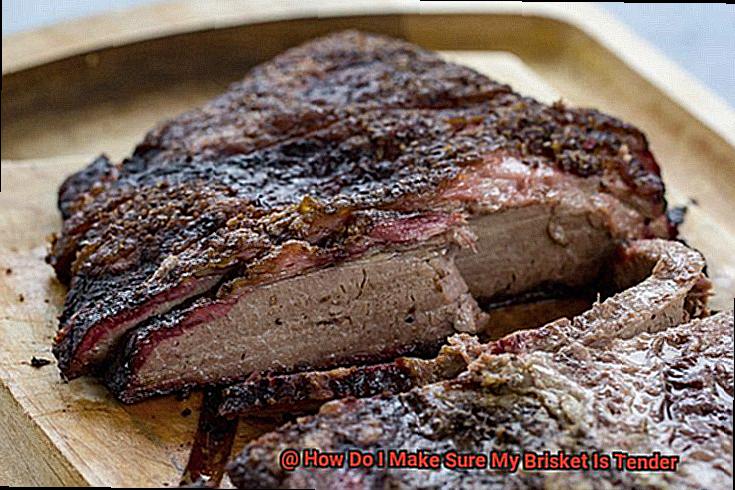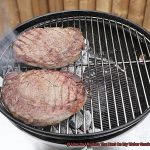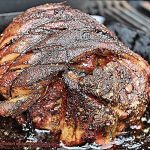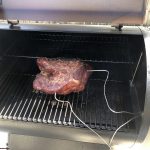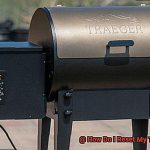Sink your teeth into a slice of heaven with tender, melt-in-your-mouth brisket. But let’s be real, getting that perfect balance of tenderness and flavor can feel like chasing a mythical creature. Fear not, my fellow barbecue aficionados. In this guide, we’re going to unlock the secrets to consistently achieving brisket nirvana that will make your taste buds beg for more.
- Pick the Perfect Cut: Embark on your quest for tender bliss by choosing the right cut of brisket. Go for top-notch beef like USDA Choice or Prime, boasting generous marbling and a righteous fat cap. This marbling keeps the brisket moist during its slow dance with fire, resulting in unrivaled tenderness.
- Spice it Up: Prepare your brisket with a rub or marinade that amplifies its natural flavors. Don’t hold back on the seasonings; make sure every inch of that meat is coated in deliciousness. Let it marinate for at least 4 hours (or better yet, overnight) so those flavors seep deep into its soul.
- Low and Slow Magic: The secret to breaking down tough connective tissues lies in the slow-cooking method. Opt for a low and steady cooking temperature around 225°F (107°C). This gentle heat allows collagen to dissolve gradually, transforming your brisket into a tender masterpiece.
- Moisture Matters: Keeping your brisket juicy throughout its journey is non-negotiable. Use a water pan or spritz it occasionally with apple juice, beef broth, or whatever liquid tickles your fancy. This extra moisture creates an environment fit for royalty and results in buttery textures that dreams are made of.
- The Resting Ritual: Once your brisket reaches its desired internal temperature (around 195°F to 203°F or 90°C to 95°C), it’s time for a sacred ritual: resting. Wrap that beauty tightly in aluminum foil and tuck it away in a cooler or insulated box for at least an hour. This divine rest allows the meat’s juices to mingle, resulting in a final product so tender and juicy, it’ll make you weep tears of brisket joy.
By following these steps and embracing the art of patience, attention to detail, and a fiery passion for the craft, you’ll ascend to brisket greatness. So, fire up your smoker
Contents
Selecting the Right Cut of Meat
Grilling a tender and flavorful brisket is an art form that starts with selecting the right cut of meat. In this article, we will explore the factors to consider when choosing the perfect cut of brisket. From grade and marbling to size and age, these factors will guide you in creating a brisket that will leave your guests in awe.
Grade and Marbling: The Secret to Unparalleled Flavor and Tenderness
To ensure a truly remarkable brisket, opt for USDA Prime or Choice grades of meat. These cuts are renowned for their superior quality. Look for generous marbling, as that fat will melt during cooking, infusing the meat with succulence and enhancing its flavor profile.
The Flat Cut vs. The Point Cut: A Battle of Sensory Delights
Understanding the nuances between the flat cut and the point cut is essential in your quest for brisket perfection. The flat cut boasts leanness and impeccable sliceability, while the point cut tantalizes taste buds with abundant marbling and a more decadent flavor. Consider your preference and cooking style when making your choice.
Packer Cut: The Best of Both Worlds
For those who crave balance, the packer cut offers an enticing solution. This cut includes both the flat and point cuts, combining lean and fatty portions in one glorious brisket. With this option, you can enjoy tenderness and richness in every bite.
Size Matters: Unlocking Tender Nirvana
The size of your brisket can impact its tenderness. Smaller briskets, weighing around 10 pounds, cook faster and have the potential to be more tender. On the other hand, larger cuts over 15 pounds require longer cooking times but can still result in exceptional tenderness when cooked with care.
Age of Beef: The Fountain of Tenderness
In your pursuit of the perfect brisket, consider the age of the beef. Younger animals yield more tender meat, making cuts from younger animals a desirable choice for optimal tenderness.
Cooking Method: Harmonizing Flavors and Techniques
Your preferred cooking method should also influence your choice of brisket cut. Some cuts excel in slow-cooking methods like smoking or braising, allowing flavors to meld together over time. Others thrive when grilled or roasted, showcasing a delectable crust and succulent interior. Align your cut selection with your desired cooking technique.
Properly Seasoning the Brisket
Properly seasoning the brisket is the secret ingredient to achieving a tender and flavorful masterpiece on your grill. When it comes to grilling, the right combination of spices and herbs can take your brisket from good to mind-blowingly delicious. So, let’s dive into the importance of seasoning and the steps involved to ensure you’re grilling like a pro.
First things first, before you even think about seasoning, it’s important to trim any excess fat from the brisket. This not only prevents flare-ups on the grill but also allows the seasoning to penetrate the meat evenly. Nobody wants a mouthful of chewy fat.
Now onto the seasoning itself. A basic seasoning blend for brisket usually consists of salt, black pepper, garlic powder, and onion powder. These ingredients provide a solid foundation for flavoring the meat. However, if you want to take it up a notch, consider adding some paprika, chili powder, cumin, or even a touch of brown sugar to create a dry rub that will elevate your brisket to new heights of deliciousness.
Once you have your seasoning blend ready, generously coat both sides of the brisket with it. Gently pat it into the meat to ensure it adheres well. Don’t be shy with the seasoning – this is where the magic happens.
After applying the seasoning, let the brisket sit at room temperature for about 30 minutes to an hour. This resting period allows the flavors to penetrate the meat while also bringing it closer to room temperature before grilling.
Now here’s a pro tip: consider using a binder like mustard or Worcestershire sauce before applying your dry rub. This not only helps keep the seasoning in place but also adds an extra layer of flavor to your meat.
Finally, don’t forget that timing is everything. Seasoning should be applied at least a few hours before grilling or even overnight. This gives ample time for the flavors to develop and penetrate into the meat fibers, resulting in a more flavorful and tender brisket.
Remember, while seasoning is crucial, it’s equally important not to overdo it. Too much salt or spice can overpower the natural flavors of the meat. Start with a moderate amount of seasoning and adjust as per your taste preferences. You can always add more later if needed.
So there you have it – the importance of properly seasoning your brisket and the steps involved to achieve grilling greatness. With these tips in mind, get ready to impress your friends and family with a perfectly seasoned and mouthwateringly delicious brisket hot off the grill.
Low and Slow Cooking Techniques
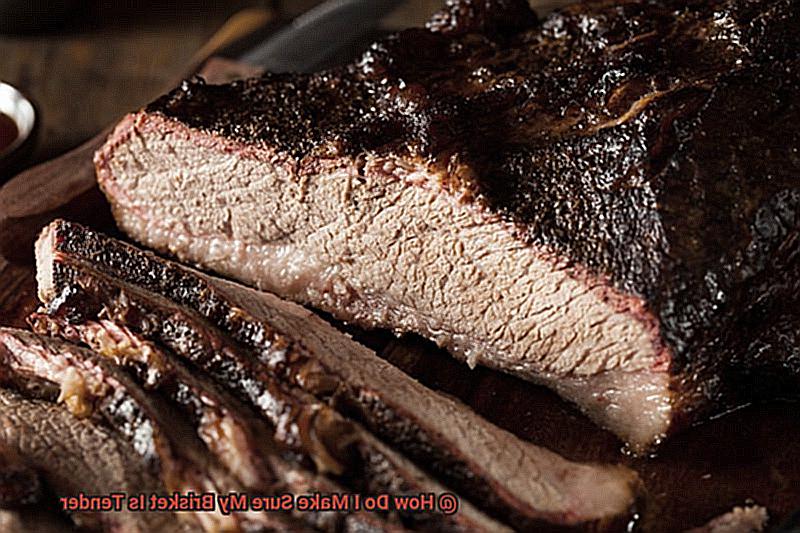
If you want to create a brisket that will make your taste buds dance with joy, then mastering the art of low and slow cooking techniques is a must. Trust me, the wait will be worth it.
Why low and slow, you ask? Let me tell you why. Brisket, a tough cut of meat, requires some extra love and attention to transform into a juicy, melt-in-your-mouth masterpiece. By cooking it low and slow, you allow the connective tissues and fats to break down gradually, resulting in a tender texture that will make you weak at the knees.
So, how can you achieve this culinary magic? Let’s dive into two popular low and slow cooking techniques: smoking and braising.
Smoking is the ultimate flavor enhancer. By cooking your brisket at a low temperature (around 225-250°F), you allow the wood smoke to infuse its tantalizing aroma and taste into every fiber of the meat. Imagine that smoky goodness mingling with savory spices and slowly tenderizing your brisket – pure perfection.
On the other hand, braising adds a whole new level of richness to your brisket. First, sear that bad boy on high heat to develop a caramelized crust that will make your mouth water. Then, simmer it in a flavorful liquid like beef broth or wine over low heat for hours. The result? A tender, succulent brisket that has absorbed all those incredible flavors from the braising liquid.
Now that we’ve covered the techniques, let’s talk about some essential steps to ensure your brisket turns out like a pro:
- Start with quality: Invest in a good piece of brisket with even marbling and a generous fat cap. This contributes to the tenderness and flavor of the final product.
- Season to perfection: Create a dry rub or marinade that complements your taste buds – think salt, black pepper, garlic powder, paprika, chili powder, cumin, or even a touch of brown sugar. Generously coat your brisket and let it sit at room temperature for 30 minutes to an hour before grilling.
- Maintain consistent heat: Whether you’re smoking or braising, keep that temperature low and steady. Fluctuations can lead to uneven cooking and potentially tough meat. Use a smoker or an oven with precise temperature control to ensure the perfect environment for your brisket.
- Internal temperature matters: Use a meat thermometer to monitor the internal temperature of your brisket. For smoking, aim for 195-205°F; for braising, aim for 190-200°F. This ensures that those connective tissues have had ample time to break down, resulting in a tender and juicy brisket.
Maintaining a Consistent Temperature
Prepare to uncover the secret that separates the amateurs from the pitmasters – maintaining a consistent temperature.
Why is temperature so crucial when it comes to cooking brisket, you ask? Let me enlighten you. Temperature fluctuations can wreak havoc on your meat, resulting in uneven cooking and a dry, tough texture. And believe me, nobody wants that disappointment on their plate.
So, let’s dive into the nitty-gritty details of how we can ensure that our brisket emerges tender and succulent every single time.
First things first – preheating your grill or smoker is an absolute must. This vital step ensures an even distribution of heat and prevents any sudden changes in temperature that could spell disaster for your brisket. Aim for a temperature between 225°F to 250°F (107°C to 121°C) – the sweet spot for low and slow cooking.
Once your grill is preheated to perfection, it’s time to channel your inner detective and monitor that thermometer like a hawk. Temperature fluctuations can be caused by various factors, such as weather conditions or constantly opening the lid. To stay ahead of the game, invest in a high-quality thermometer specifically designed for grilling and smoking. Trust me, it’s a small price to pay for consistent success.
Here’s a little trick I’ve picked up along my grilling journey – indirect heat. Place a drip pan filled with water underneath your brisket. This not only regulates the temperature but also prevents flare-ups caused by dripping fat. The water acts as a buffer between the intense heat source and the meat, creating an environment that promotes stable cooking. Genius, isn’t it?
While we’re on the subject of lids, I need to stress this – resist the urge to constantly peek under that lid. Every time you do, precious heat escapes, leading to temperature fluctuations that can sabotage your brisket masterpiece. Trust your thermometer and only open the lid when absolutely necessary, like when applying a glaze or checking for doneness towards the end of the cooking time.
Oh, and let’s not forget about the internal temperature of the brisket itself. The magic number to aim for is around 195°F to 205°F (90°C to 96°C). This allows the collagen in the meat to break down, resulting in that tender, melt-in-your-mouth goodness we all crave. A reliable meat thermometer is your best friend here too – it ensures you hit that perfect sweet spot every time.
Utilizing Drippings, Basting, and Wrapping
Brisket – the holy grail of grilling. It’s the epitome of tender, flavorful, and succulent meat that can elevate any backyard barbecue to legendary status. But how do you achieve that perfect brisket? The secret lies in mastering the art of utilizing drippings, basting, and wrapping. In this blog post, we’ll delve into the details of these techniques and show you how they can take your brisket from good to exceptional.
Collecting and Utilizing Drippings:
Drippings are liquid gold when it comes to brisket. They contain essential fats and proteins that add flavor and moisture to the meat. To capture these precious drippings, place a drip pan or aluminum foil beneath the brisket during cooking. Not only does this prevent mess, but it also enables you to use the drippings for basting or creating a delicious sauce. Trust us, once you taste the magic of incorporating these drippings into your brisket, you’ll never want to grill without them.
The Power of Basting:
Basting is a game-changer for keeping your brisket moist and tender. Regularly coating the meat with flavorful liquids infuses it with additional moisture and enhances its taste. Whether you opt for a marinade or a mixture of seasonings and liquids, basting forms a protective layer on the surface of the brisket, preventing it from drying out during cooking. Use a basting brush or spray bottle to generously coat every inch of the meat, ensuring even distribution.
Wrapping for Juicy Goodness:
The Texas crutch – a technique involving wrapping your brisket in foil or butcher paper – is a tried-and-true method for achieving a tender and juicy end product. Wrapping the brisket creates a steamy environment that helps retain moisture and promotes tenderness. The tightly wrapped package effectively braises the meat in its own juices, resulting in a melt-in-your-mouth texture. Whether you choose foil or butcher paper, ensure a tight seal to lock in the moisture and maintain a consistent temperature.
Understanding the Stall Stage
Imagine yourself in your backyard, the grill ablaze, as the tantalizing aroma of a slowly cooking brisket fills the air. Your mouth waters in anticipation of that tender, juicy slice of meat. But then, unexpectedly, the temperature stalls. Panic sets in. Has something gone wrong? Fear not, my fellow grillers, for understanding and embracing the stall stage is the secret to achieving that coveted tender brisket.
So grab a cold drink, relax, and let’s dive into the fascinating world of the stall stage.
The Stall Stage Demystified:
The stall stage is a pivotal part of the cooking process where the internal temperature of your brisket plateaus or even drops for a while. It typically occurs when your brisket reaches around 150-160°F (66-71°C) and can last from 1 to 4 hours. Don’t fret; it’s completely normal. In fact, this temporary halt is essential in transforming your brisket from good to exceptional.
Why Does the Stall Occur?
During the stall stage, magic happens within your brisket. Collagen, responsible for toughness, breaks down into gelatin, resulting in that melt-in-your-mouth texture we all crave. The stall occurs due to evaporative cooling – as moisture on the surface of the brisket evaporates, it cools down the meat, counteracting the heat from your grill or smoker.
Patience is Key:
When encountering the stall stage, resist the urge to rush or force the temperature to rise. This slow breakdown of collagen is what ultimately leads to a tender brisket. Embrace your inner Zen master and let nature take its course. Trust me; it’ll be worth it.
To Wrap or Not to Wrap:
Some grillers choose to wrap their briskets in foil or butcher paper during the stall stage to accelerate the cooking process. This technique, known as the “Texas crutch,” helps overcome a stubborn stall and reduces overall cooking time. The tightly sealed wrap creates a steamy environment that braises the meat in its own juices, resulting in incredibly tender and flavorful brisket slices.
Monitoring the Temperature:
During the stall stage, it’s crucial to monitor the internal temperature of your brisket using a reliable meat thermometer. This allows you to track its progress and ensure it reaches the desired tenderness without overcooking. Remember, knowledge is power.
The End of the Stall:
Once the stall stage ends and the internal temperature starts rising again, it’s a clear sign that the collagen has fully broken down. Your brisket is now on its way to becoming a masterpiece. Take a moment to revel in your achievement.
Letting the Brisket Rest Before Slicing
Brace yourselves, because I am about to unveil the secret to achieving brisket nirvana – the power of resting. Just like us after a long day, brisket needs time to unwind and relax before revealing its full potential.
Tenderize through Relaxation
Imagine this: hours spent meticulously tending to your brisket on the grill. As the collagen melts away during the stall stage, tough meat transforms into tender bliss. But hold your knives. By hastily diving into slicing, you deny the brisket the opportunity to rest and reach its peak tenderness. Allowing it to cool down gradually lets those meat fibers relax and retain moisture, resulting in melt-in-your-mouth goodness.
Flavorful Juicy Magic
Resting is like witnessing a magical dance of flavors. During this crucial period, savory juices perform an enchanting redistribution throughout the meat, creating an explosion of taste in every bite. This mesmerizing act also safeguards against the dreaded dry-out phenomenon that strikes when you cut too soon. Patience is key – give those juices time to work their irresistible magic.
The Perfect Timing
Now that you understand the significance of resting, let’s discuss timing. Experts suggest a minimum of 30 minutes to an hour for your brisket to rest. While it luxuriates, you can tent it with foil, ensuring its warmth and coziness. Seize this moment to whip up delectable sides or craft a tantalizing sauce that will perfectly complement your masterpiece.
Embrace the Juiciness
As you uncover your rested brisket, don’t be startled by the sight of tantalizing juices on the surface. Embrace it. These flavorful drippings are a testament to the resting process and must be cherished, not discarded. They enhance the moisture and juiciness of each slice, guaranteeing an unforgettable eating experience.
Tips for Perfecting Your Brisket
There’s nothing quite like sinking your teeth into a perfectly cooked brisket – tender, juicy, and bursting with flavor. But achieving that mouthwatering result takes some know-how and technique. Fear not. We’ve got you covered with these tips for perfecting your brisket on the grill. From selecting the right cut to mastering the art of low and slow cooking, you’ll soon be grilling up a brisket masterpiece that will leave your guests begging for seconds.
Choosing the Right Cut: Set Yourself Up for Success
To ensure a tender brisket, start with a high-quality cut of meat. Look for one that is well-marbled, as the fat will keep the meat moist during cooking. There are two main cuts to choose from: the flat cut and the point cut. The flat cut is leaner but can be drier if not cooked properly, while the point cut has more fat, resulting in a juicier end product. Consider your preferences and cooking style when making your choice.
Master the Trim: A Little Fat Goes a Long Way
While fat adds flavor and moisture, trimming excess fat is essential for even cooking. Remove any thick layers of fat, leaving about ¼ inch to retain flavor and tenderness. Also, remove any silver skin, as it can cause chewiness in the final product.
Rub It Down: Flavor Explosion Awaits
A dry rub adds depth and enhances tenderness. Mix salt, pepper, garlic powder, onion powder, and paprika for a classic combination. Massage this flavorful mixture into the meat, ensuring all sides are well-coated. Let it marinate in the refrigerator for at least 4 hours or overnight to allow the flavors to penetrate and tenderize the meat.
Low and Slow: The Secret to Tenderness
Cooking brisket at a low temperature for an extended period is the key to tender perfection. Aim for a temperature around 225°F and cook for about 1 hour per pound of brisket. This slow cooking process breaks down tough connective tissues and results in melt-in-your-mouth tenderness.
Indirect Heat: Keeping It Steady and Even
When grilling or smoking brisket, use indirect heat. Place the brisket on one side of the grill while keeping the heat source on the other side. This allows for slower, more even cooking, preventing overcooking or drying out.
Rest and Slice: The Final Touches
Once the brisket reaches an internal temperature of 195-205°F, remove it from the heat and let it rest for at least 30 minutes. This allows the juices to redistribute throughout the meat, ensuring ultimate tenderness. When it’s time to slice, cut against the grain for maximum tenderness and easy chewing.
Conclusion
To ensure your brisket turns out tender, there are a few key tips to keep in mind. First and foremost, it’s crucial to choose the right cut of meat. Opt for a well-marbled brisket, as the fat will help keep it moist during the cooking process.
Next, take the time to properly season your brisket. A flavorful rub or marinade can work wonders in enhancing tenderness. Be sure to generously coat all sides of the meat, allowing it to penetrate and infuse delicious flavors.
When it comes to cooking, low and slow is the name of the game. This means using low heat and giving yourself plenty of time for the collagen in the meat to break down and transform into gelatin. This process takes patience but is essential for achieving that melt-in-your-mouth texture.
Consider using a slow cooker or smoker for optimal results. These methods allow for consistent heat distribution and create an environment that encourages tenderness. Just be sure to monitor the temperature closely and adjust as needed.
Lastly, don’t rush the resting period after cooking. Allowing your brisket to rest for at least 30 minutes before slicing will help retain its juices and ensure every bite is tender and succulent.
By following these steps with care and precision, you’ll be well on your way to serving up a mouthwatering brisket that’s tender beyond compare.

